In honor of Arbor Day today, I am posting about one of my favorite trees native to Oklahoma.
Probably the most beautiful natural plant growing in the state is the Oklahoma Redbud Tree (Cercis reniformis). [By the way, Cercis is pronounced Sur-sis.] This post contains many pictures of this tree and only one of the pictures was taken more than 3 miles from my house - most of them are from within a couple of blocks.
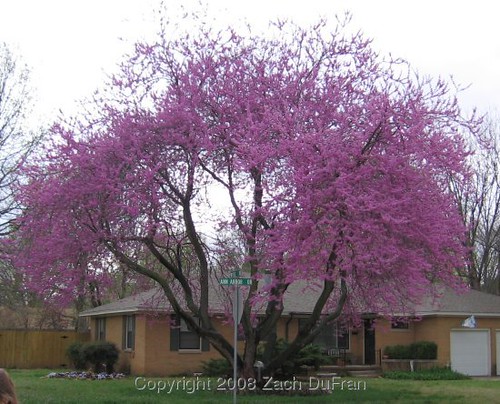 |
| Large Redbud Tree (Cercis reniformis) in my neighborhood. Sadly, about a third of this tree was damaged and lost in the December 2007 ice storm, but it is still alive and blooming each Spring. |
To me, this tree is tied to the part of our state history that most Americans know pretty well. Oklahoma was first opened to settlers in a series of "Land Runs," where prospective owners lined up and waited for a gunshot before setting off to stake a claim to their future homeland. [The final 30 minutes of the movie "Far and Away," starring Nicole Kidman and Tom Cruise, captures the moment in history.]
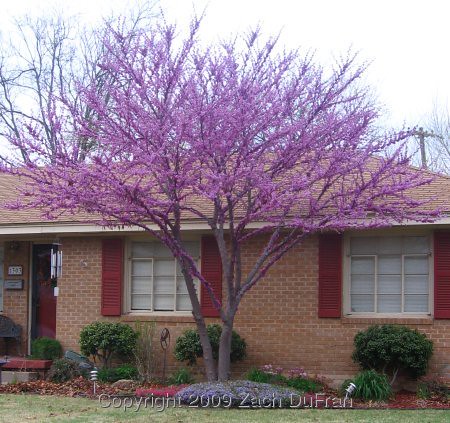 |
| Beautiful Redbud tree (Cercis sp.) in another neighbor's yard. |
My wife's family was involved in the Land Run of 1889 and claimed the land where my parents-in-law currently live, surrounded by dense woods. Much of the land has been untouched and is in its pristine, natural state. Last Spring, my wife and I wandered around on the land and dug up some of the Oklahoma Redbuds (Cercis renifomis) which grow there naturally and transplanted them to our house. In our day and age, most everything I have growing at my house was started in a greenhouse or by some professional grower and transplanted to my yard. These transplanted native trees are a little more special, knowing that they were never touched by human hands before me. They are completely the artifacts of nature, with no human intervention.
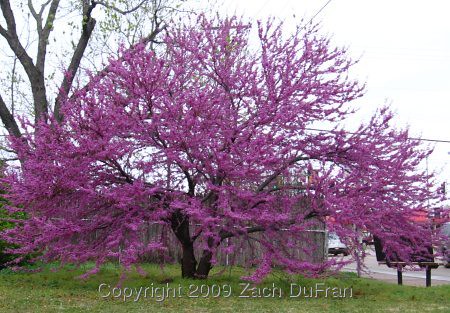 |
| A wonderful, old Redbud (Cercis reniformis) near our house. |
[I should note here that we only transplanted two trees and did not destroy any ecosystems. The trees seed very well and there are many more to take their place. The balance of nature has not been disturbed.] :)
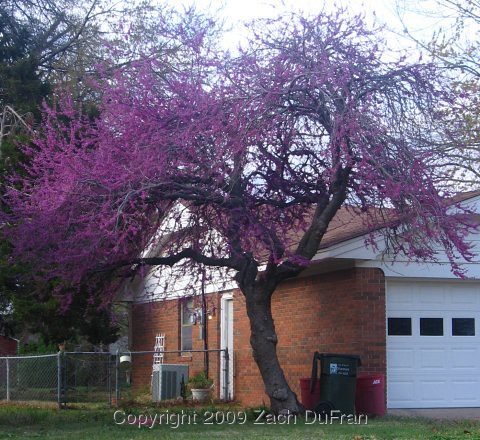 |
| A beautiful, old Redbud (Cercis reniformis). Try to ignore the trash cans sitting under this tree. |
When my wife and I went out on our Redbud transplanting expedition, my parents-in-law warned us that our transplants wouldn't survive. In the 15 years they have lived there, they have tried relocating some of the trees from deeper in the woods to a location visible from their house. They have never had a successful transplant. That didn't bother us much. We barely even got roots with our two 6-8 foot saplings, but both of them survived the transplant and are growing very well in our yard.
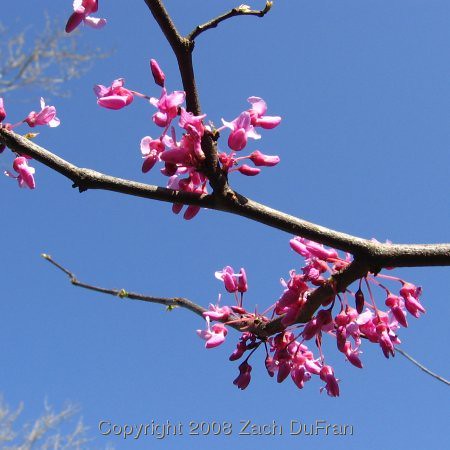 |
| Oklahoma Redbud Tree (Cercis reniformis) blooms. This is one of the trees we transplanted from my wife's family's land to our yard in town. |
The Redbuds in town start blooming in mid March, with the Redbuds outside of town following 2 to 3 weeks later. My wife and I have observed this consistent phenomenon for the last several years. We assume that it is attributable to the "heat island" effect, but I'm kind of surprised that the small city of Norman, Oklahoma would have such a strong affect. [According to the US EPA website, a city with a population of 1 million people will be 1-3 degrees Fahrenheit warmer than the surrounding rural areas. Norman is just about 100,000 in population.]
The blooms persist for more than a month and then fall away as the trees start to leaf out. I wanted to add some more pictures to this post to show the variability in coloration and form of different Redbud trees. There are wonderful examples all over town, but what better place to go than a college campus for beautiful trees and landscaping? The University of Oklahoma is right here in my hometown of Norman, Oklahoma.
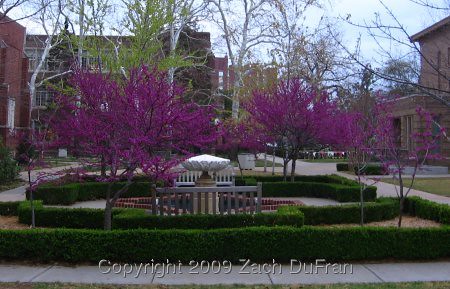 |
| Redbud trees (Cercis sp.) on campus of the University of Oklahoma |
 |
| Redbuds (Cercis sp.) planted along the length of the University of Oklahoma women's soccer field. |
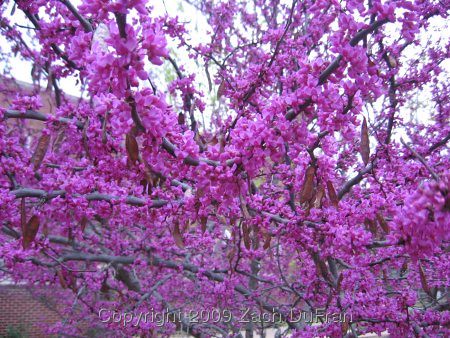 |
| Redbud (Cercis sp.) blooms and hanging seed - University of Oklahoma campus |
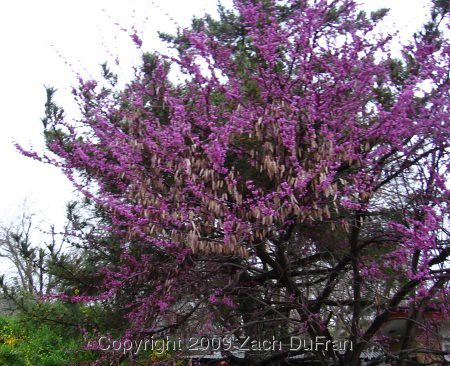 |
| Redbud tree (Cercis sp.) covered in seeds and blooms across the street from us. |
 |
| One of our transplant Redbuds (Cercis reniformis) beginning to leaf out. |
There is a pretty large Redbud tree in our neighbor's yard, right next to our shared fence. The tree overhangs our yard and sheds its seed. We have quite a few little 3-4" saplings that come up every Spring. I have transplanted several of them to pots to let them mature, while the others get mowed over.
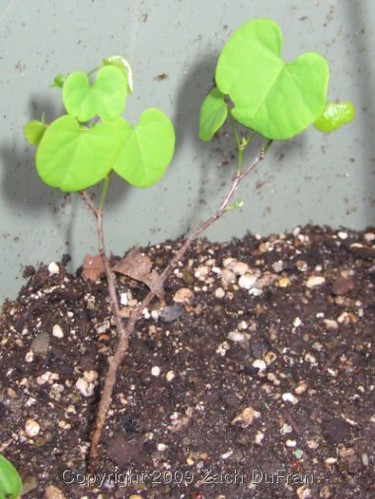 |
| Small Redbud tree (Cercis reniformis) that grew in our yard - about 4 inches tall. |
After they have gotten large enough, I will give these little trees away to friends and family that want a Redbud tree.
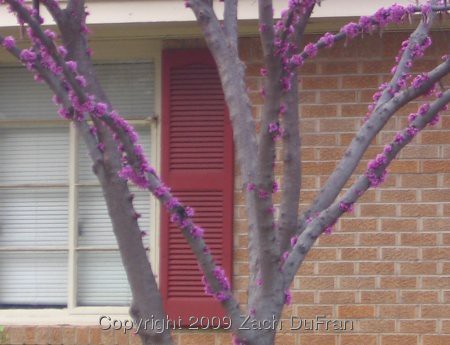 |
| Redbud (Cercis sp.) blossoms forming in clumps along the branches of a tree in our neighborhood. |
I carried my camera around town with me for a couple of days and took pictures of about 50 different Redbud trees. I was hoping to show the color variation in these trees, but the pictures don't quite show what I see with my own eyes. Regardless, I have lots of beautiful Redbud pictures. I
was successful in documenting the different forms of trees that I have seen. The older trees more closely resemble the native trees that my wife and I saw when we went hunting in the woods. The newer trees that are being planted in many yards are nursery-grown and nursery-"improved" trees. I don't know if the trees are actually different species or if the nursery does something to "improve" the trees. They usually have much thicker trunks and the branches are more dense.
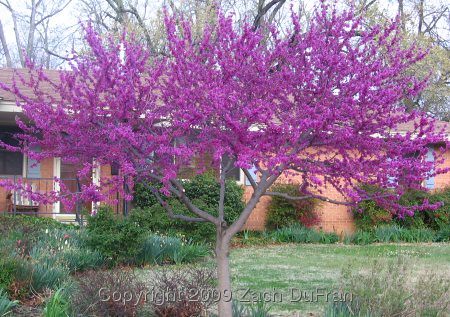 |
| A nursery-grown Redbud tree (Cercis sp.). The form of this tree is very different than the ones you find naturally growing in Oklahoma. It might be an Eastern Redbud (Cercis canadensis), but I don't know for sure. |
Most of these nursery trees are really well shaped. Some are not (below).
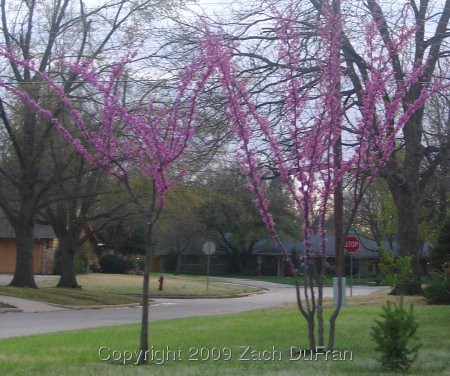 |
| Two very funny looking Redbuds (Cercis sp.) growing in a neighborhood near my house. The one on the right looks more like a Crape Myrtle than a Redbud. |
The nursery-grown trees are beautiful, but I wonder if they will be much like the Bradford Pear Trees that are all over town. The Bradford Pears have been improved for branch density so much that they are constantly splitting because they can't support their own weight.
The Redbuds that I see around town that are
not Oklahoma Redbuds (Cercis reniformis) are most likely the Eastern Redbud (C. canadensis), which I see a lot at nurseries. A couple of weeks ago I saw a new variety of the Eastern Redbud (Cercis canadensis) for sale. It is called 'Forest Pansy,' and has shiny wine red leaves in the Spring, which turn green but keep the purple tinge during the Summer. In Fall, the leaves turn yellow and orange like many other trees, while keeping some green and purple as well. I imagine this will become a very popular tree. You can read some more about the cultivar
here. After seeing one specimen at the store, I saw two planted at the Fort Worth Botanic Gardens over the weekend. They had begun to turn green and I really liked the mix of red and green leaves.
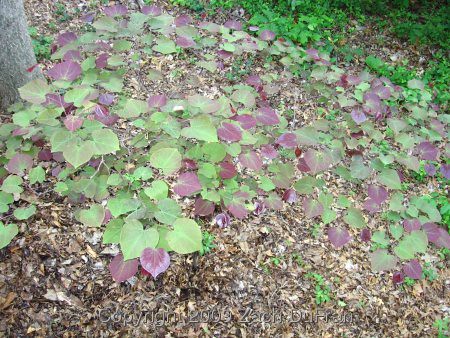 |
| Cercis canadensis 'Forest Pansy' at the Fort Worth Botanical Gardens |
Another interesting species in the Cercis genus is Cercis siliquastrum, the Judas Tree. This tree grows in the Mediterranean region. It derives its common name from a supposed myth that states that this is the species of tree by which Judas Iscariot hung himself after betraying Jesus Christ to the Roman soldiers. There is speculation that this name and the associated legend came from a mix up in translation, whereas the name should actually be "Tree of Judea," not "Judas Tree." Since the tree grows in the region of the New Testament events, someone mistranslated and then a legend was born. A motive was not established, but the tree was in the right place at the right time.
I hope you have enjoyed my Redbud pictures. If you're interested in a little sapling, let me know! I have several available.
For full disclosure, I must admit that I don't know the exact species of many of the pictures in this post. The Cercis genus is composed of about 20 species of trees. I have seen Redbud trees around town with varying colors (from bright pink to dark purple) and varying forms (from short and stalky to long and sparse branches). However, I am not enough of an expert on this genus to pick out the different species. I happen to know that the greenhouse grown trees have a shorter, thicker form than the ones that I find naturally growing in Oklahoma forests. I also know that some of the color variation just depends on what phase of bloom the tree is in. Before the buds open they are dark purple and the blooms turn lighter pink as the petals emerge. I tried to label all pictures accurately. When "Cercis sp." is used, I don't know the exact species.














Happy Arbor Day! I just love the red bud trees, they are
ReplyDeletedifferent than most trees. The color of them are very
pretty too.
Nice trees. In California we have the western redbud, C. occidentalis, which looks very similar to the trees you've shown. It needs to drop to 28 for the flowers to be anything to talk about, so they're not one of our more commonly planted trees here at the coast, though they are gaining somewhat in popularity.
ReplyDeleteZach -those are beautiful. Cercis other than "forest pansy" and the judas tree C. silaquastrum are fairly rare in cultivation in the uk. I think they could be one of those genera about to attract a lot more attention.
ReplyDeleteVery informative! We have the eastern redbud out here in TN. I wouldn't be shocked to see the two kinds hybridize into something else, they appear so similar. Even among the eastern redbuds there seem to be color differences in the blooms. I wonder if it may be something with the soil of if it's just new unnamed cultivars brought to us by Mother Nature. I know with many of the redbud trees grown in nurseries that they come from grafts onto rootstock grown from seed. Our 'Forest Pansy' was made that way. In fact three of the six redbuds there at the store were simply eastern redbuds that were mislabeled and not 'Forest Pansy'. I was able to tell for sure by the graft.
ReplyDeleteGreat photos, my good man. I appreciate your diligence to document this beautiful "Oklahoma tree." Perhaps you can help me with a question I have. My landscaper told me something to the effect that redbuds produce new branches every year but only flower on that branch in the branch's second year. Is that correct? Also, to produce a redbud tree with a central trunk and a proportionate canopy, when is it proper to prune the lower branchs that extend from the main trunk? Thanks in advance. Brian
ReplyDeleteHow long before your 6-8 ft specimen bloomed?
ReplyDeleteI've read that until they are 17 years old they won't bloom! Could that be true?!
I live in OKC, and have planted one so far that died, and have another one about the same size (1-2 ft. tall) I am going to plant this Fall.
Any advice on how to care for them?
Jo
In answer to Jo's question:
ReplyDeleteI dug two redbud trees up from the woods and replanted them in my yard. They were blooming when I dug them up and have continued to bloom each Spring since then (2 years). I would be very surprised if my two trees (about 8 feet now) are already 17 years old. It is more likely that they are between 5 and 10 years old, though I couldn't say for sure.
As far as care is concerned, my trees have taken care of themselves pretty well. I watered them regularly (about once a week) when they were newly planted and have watered them every once in a while when it is very hot and dry. But they are natives here in Oklahoma and do very well once they are established in their location.
Hello, I have been trying to source some authentic Cercis reniformis seed. If you have any and would like to sell or trade please contact me at revron@greenenatives.com or more preferably, the e-mail address I used to post this comment.
ReplyDeleteI have transplanted many redbud trees, both lighter pinkish forest pansy (eastern) redbuds, and the dark reddish purple "oklahoma redbud" species.
ReplyDeleteThe key to success every time is to find the redbud in the early spring and tie yourself a good marker on it (loosely but securely) that wont rot off (also a gps coordinate comes in handy if you have a good gps that works in heavy cover). Wait until fall, and go dig it up and then go plant it where you want it. As you discovered you don't have to get all the roots...redbuds are very sturdy.
I am happy to find this sight. Many good infos for Redbud trees of varing kind. It also shocked me how big this Oaklahoma Redbud tree can grow. I now have collected and planted 6 of different named Redbud trees.
ReplyDeleteThe first one I planted was Western Redbud about 4 years ago. This, mine grows more uprighted multiple trunks and beautiful pink flowers on grey colored bark. Anyhow, I just fell in love with it and started collecting different species?. Now I have Western, Eastern, Oaklahoma, Forest pansy and the other two I got had no clarification when I purchased from local nursery. My western and Oaklahoma are blooming beautifully now. I can't wait until my Oaklahoma grows to be a big tree. Now it is about 5' tall. I love to post photos if there is a way. please visit my YouTube channel site called LaMarAzura. There I used my photos of my redbud in different clips especially Oboe Concerto clip. Thanks and I am in So California.
Zach, I am trying to find a couple of redbud trees with a deep amithyst purple color, like the one you show on the U of OK campus, near a small fountain or bird bath. Your picture identifies this as Cercis sp. But other pictures with the same identification show a color that is more lavender-pink. Can you tell me how I can get (purchase) trees that will have that dark purple color?
ReplyDeleteThank you,
Frank